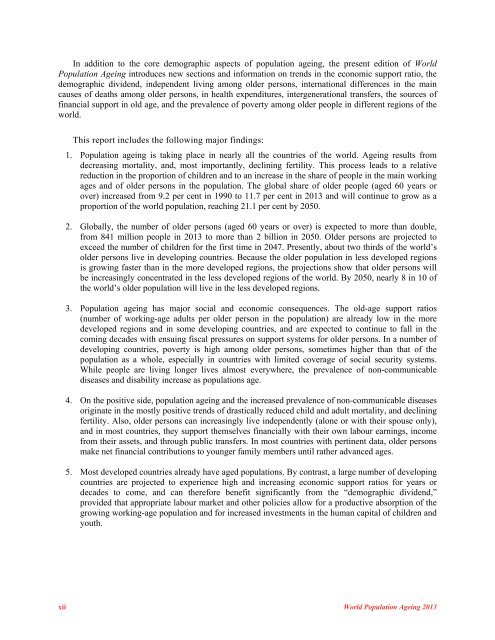yUy5H
yUy5H
yUy5H
Create successful ePaper yourself
Turn your PDF publications into a flip-book with our unique Google optimized e-Paper software.
In addition to the core demographic aspects of population ageing, the present edition of WorldPopulation Ageing introduces new sections and information on trends in the economic support ratio, thedemographic dividend, independent living among older persons, international differences in the maincauses of deaths among older persons, in health expenditures, intergenerational transfers, the sources offinancial support in old age, and the prevalence of poverty among older people in different regions of theworld.This report includes the following major findings:1. Population ageing is taking place in nearly all the countries of the world. Ageing results fromdecreasing mortality, and, most importantly, declining fertility. This process leads to a relativereduction in the proportion of children and to an increase in the share of people in the main workingages and of older persons in the population. The global share of older people (aged 60 years orover) increased from 9.2 per cent in 1990 to 11.7 per cent in 2013 and will continue to grow as aproportion of the world population, reaching 21.1 per cent by 2050.2. Globally, the number of older persons (aged 60 years or over) is expected to more than double,from 841 million people in 2013 to more than 2 billion in 2050. Older persons are projected toexceed the number of children for the first time in 2047. Presently, about two thirds of the world’solder persons live in developing countries. Because the older population in less developed regionsis growing faster than in the more developed regions, the projections show that older persons willbe increasingly concentrated in the less developed regions of the world. By 2050, nearly 8 in 10 ofthe world’s older population will live in the less developed regions.3. Population ageing has major social and economic consequences. The old-age support ratios(number of working-age adults per older person in the population) are already low in the moredeveloped regions and in some developing countries, and are expected to continue to fall in thecoming decades with ensuing fiscal pressures on support systems for older persons. In a number ofdeveloping countries, poverty is high among older persons, sometimes higher than that of thepopulation as a whole, especially in countries with limited coverage of social security systems.While people are living longer lives almost everywhere, the prevalence of non-communicablediseases and disability increase as populations age.4. On the positive side, population ageing and the increased prevalence of non-communicable diseasesoriginate in the mostly positive trends of drastically reduced child and adult mortality, and decliningfertility. Also, older persons can increasingly live independently (alone or with their spouse only),and in most countries, they support themselves financially with their own labour earnings, incomefrom their assets, and through public transfers. In most countries with pertinent data, older personsmake net financial contributions to younger family members until rather advanced ages.5. Most developed countries already have aged populations. By contrast, a large number of developingcountries are projected to experience high and increasing economic support ratios for years ordecades to come, and can therefore benefit significantly from the “demographic dividend,”provided that appropriate labour market and other policies allow for a productive absorption of thegrowing working-age population and for increased investments in the human capital of children andyouth.xii World Population Ageing 2013


